More of AMD’s Brazos E-350 with the MSI X370 and Sony VAIO YB
by Jarred Walton & Dustin Sklavos on March 14, 2011 4:50 PM ESTWhat About the Games?
Our HP dm1z review already covered gaming, so we’ll start with a retread of the current status quo for modern games. While the 3DMark results on the previous page may be somewhat useful, they’re no replacement for real games. First up is our usual suite of eight titles from the last year or so, many with support for advanced rendering features like DX11. While the HD 6310M does technically support DX11, so far we haven’t found any games where the feature is beneficial, as performance is too slow with it enabled.
Here are the minimum detail performance results for our test laptops, compared to a recent selection of other laptops. We have everything from Arrandale’s HD Graphics and Sandy Bridge’s HD 3000 Graphics to discrete GPUs like the GT 335M and HD 5650. We’ve also got AMD’s older IGPs (HD 4225 and HD 4250) for comparison, and the MacBook’s 320M thrown in for good measure. This isn’t going to be very pretty….
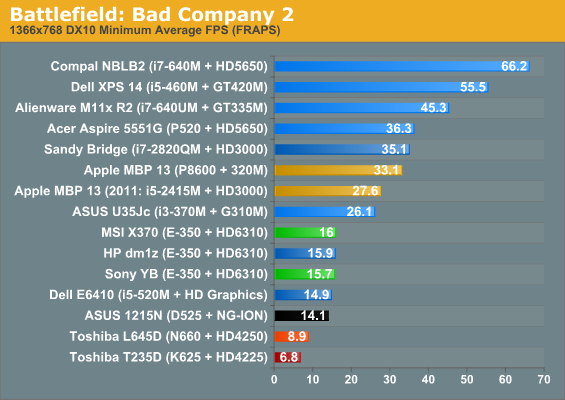
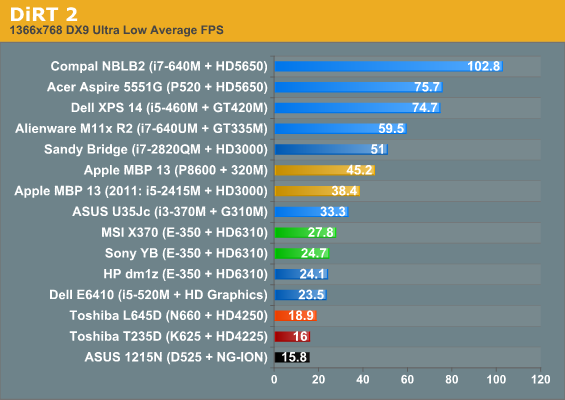
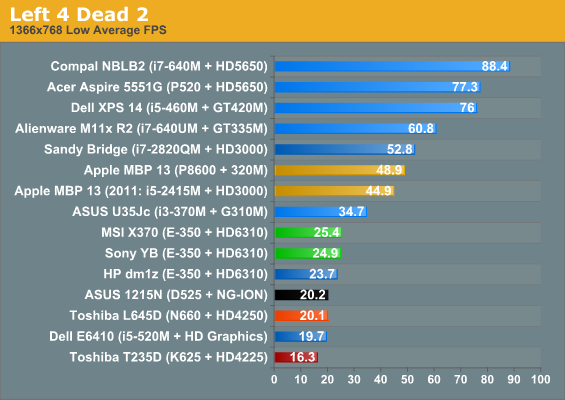
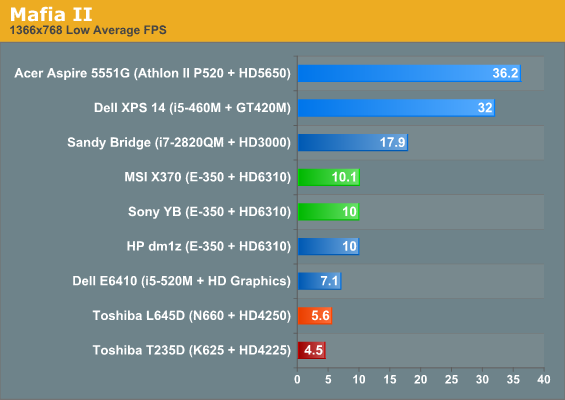
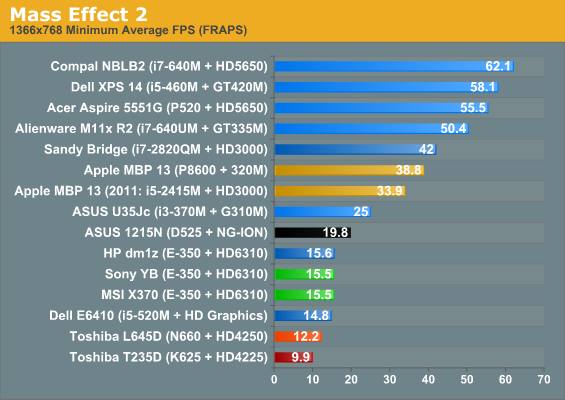
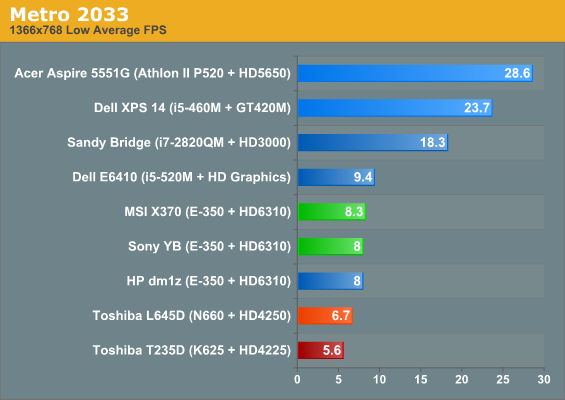
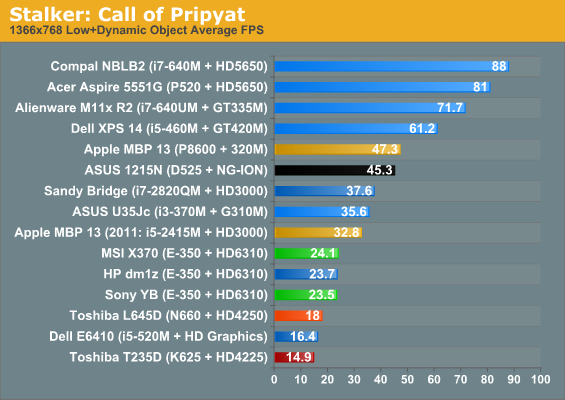

So running at the native 1366x768 found on so many consumer laptops today, the E-350 manages to break 30FPS in exactly zero out of eight games. Ouch. Scores from all the E-350 laptops are close enough that we won’t worry about it too much—the biggest gap is the dm1z lead of 19% in SC2, while there’s also an MSI X370 lead of 15% in DiRT 2; the other titles are single-digit percentage differences. E-350 does manage to beat the HD4250 and HD4225 laptops in every game, with the exception of StarCraft II where the CPU bottleneck is bigger than the GPU bottleneck at minimum details. E-350 is also generally faster than Atom + ION, but ION does lead in ME2 and Stalker. Another interesting comparison is the Dell E6410 with Intel’s HD Graphics; we’re looking at a CPU that’s easily twice as fast as E-350, but with a slightly slower IGP. The result is that (similar to the HD4250 with P660) the only case where E-350 loses in terms of gaming potential is StarCraft II, and even there HD Graphics is only 14% faster.
Move up into the next category of performance, though, and HD 6310M can’t compete. Sandy Bridge is faster than Arrandale, with roughly double the IGP performance, so the high-end i7-2820QM has an easy lead over E-350. Going off the numbers of the newer MacBook Pro 13, the dual-core Sandy Bridge models will be a bit slower than the quad-core in terms of GPU performance, but still 35 to 120% faster than E-350. More importantly, the dual-core SNB managed to break 30FPS in six out of eight titles. (Vivek didn’t test Mafia II or Metro 2033, but you really need a discrete GPU to come anywhere near playability in those games.) Similarly, the 2010 MacBook/MacBook Pro 13 is much faster than E-350, posting frame rates that are 63 to 150% higher. We hardly even need to mention discrete GPUs like the HD 5650, but we will: it’s up to 260% faster with a P520 CPU, and 315% faster with the i7-640M.
It would be interesting to see just how far the HD 6310 could go if it were untethered from the Bobcat core. Ultimately, once Llano launches in a few months it won’t matter, but for now many modern titles need something more than the current AMD IGP. But what about older games? You asked, and I’ve been pulling out a bunch of older stuff to put the E-350 through its paces….










43 Comments
View All Comments
lammers42 - Tuesday, March 15, 2011 - link
"Contrary to what you might expect, the 64Wh battery actually more than doubles battery life, suggesting the cells may be higher quality than in the 4-cell option."I've been telling everyone this for a long time . . . if you have the choice choose the higher capacity battery . . . they seem to use better performing cells.
It still doesn't explain why there is such a big difference between the different manufacturers in the quality of batteries of approximately the same capacity used which is evident from the relative battery life chart you show. As you get more Brazos systems to test it will be interesting to see if that will hold true.
Tasslehoff Burrfoot - Tuesday, March 15, 2011 - link
Brazos platforms should be under 350$ and at least under 400$. These manufacturers are getting carried away and they're even making fail noteboooks to top that off -_-All Zacate notebooks I've seen this far have either had disappointing specs (too little memory or too small resolution with too large display size or usin some lower processor model than the E-350) or horrible looks...
...or both.
Where is my all black matte ~12'' brazos lappie with sturdy chassis, 1440x900 resolution and an outstanding battery life? Why can't anybody get this simple thing right?
blacklist - Tuesday, March 15, 2011 - link
the closest approximation to what you want is probably the lenovo x120e. or just wait for the upcoming lenovo s205.silverblue - Wednesday, March 16, 2011 - link
3GB is more than enough for something this size, in my opinion. You're not going to be throwing massive workloads at the thing. I don't see why you'd want a 1440x900 resolution unless you're not gaming or the games aren't particularly tough on the hardware to begin with; what would you personally use a Brazos machine for, if I may ask?heraldo25 - Thursday, March 17, 2011 - link
I'm wondering how the E-350 and C-50 would fare against the first generation of Pentium M processors, are there any benchmarks like that?L. - Friday, March 18, 2011 - link
The first generation of pentium M processors were extremely bad iirc.If this beats a cheap C2D , it beats a pentium M. (or I don't remember which one is the pentium M, either way beating a cheap C2D is decent performance indeed).
But in all fairness, comparing the brazos to a pentium M is an insult to the brazos because the pentium M was a p3-P4 design mix, two designs that never handled multithreading in a decent fashion, and never got close to either AMD in that regard, or the subsequent C2D, which in most non-single-thread applications was much much faster.
So if you want comparisons, start with a decent chip, like a cheap C2D, or if you want to go back even more, barton athlons (yes, because those could do multithreading).
silverblue - Saturday, March 19, 2011 - link
I'd be more interested in comparing to Athlon 64s, both the single core variants and the X2s, considering AMD said Brazos should be close in performance to a similarly clocked Athlon 64 (90% I believe).JarredWalton - Saturday, March 19, 2011 - link
I suppose it depends on which Athlon 64 chip you're looking at. The K625 is actually clocked at 1.5GHz compared to 1.6GHz on the E-350. If we just focus on tasks that are pure CPU benchmarks:Cinebench 10 Single-Core: K625 is 47% faster
Cinebench 10 Multi-Core: K625 is 47% faster
x264 First Pass: K625 is 40% faster
x264 Second Pass: K625 is 29% faster
If they were aiming for 90% of the recent K10.5 Athlon II X2 chips, then, they didn't come anywhere near their goal. However, K10.5 is around 5-10% faster than K10, and K10 is probably another 15% faster than K8, so 90% of the original Athlon X2 parts is probably about right.
GTKevin - Tuesday, March 29, 2011 - link
Has anyone released a brazos platform laptop with a rotatable touchscreen so that it can be used as a tablet? I know the form factor will be bulky compared to a dedicated tablet, but for someone who is currently tabletless and likes to read ebooks in his free time, such a product would be very useful.aop - Tuesday, April 5, 2011 - link
Any hope on you guys taking apart a Fusion laptop like HP DM1z and make article about it's internals? It would be nice to see how the cooling is done and what kind of layout do the motherboards have etc.